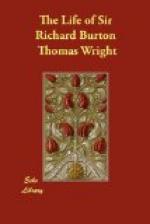Miss Stisted’s novel was her first and last, but she did write another book some considerable time later, which, however, would not have won Mrs. Burton’s approval.[FN#330]
101. The Kasidah, 1880.
This year, Burton, emulous of fame as an original poet, published The Kasidah of Haji Abdu El-Yezdi, A Lay of the Higher Law, which treats of the great questions of Life, Death and Immortality, and has certain resemblances to that brilliant poem which is the actual father of it, Edward FitzGerald’s rendering of The Rubaiyat of Oman Khayyam. Lady Burton tells us that The Kasidah was written about 1853, or six years before the appearance of FitzGerald’s poem. Nothing, however, is more certain than that, with the exception of a few verses, it was written after FitzGerald’s poem. The veriest tyro in literature, by comparing the two productions, would easily understand their relationship.[FN#331] The facts are these. About 1853, Burton, in a time of dejection, caused by the injustice done him in India, planned a poem of this nature, wrote a few stanzas, and then put it by and forgot all about it. FitzGerald’s version of Omar Khayyam appeared in 1859, and Burton no sooner read than he burned to rival it. So he drew from the pigeon-hole what he called his Lay, furbished up the few old verses, made a number of new ones, reconstructed the whole, and lo, The Kasidah! Burton calls it a translation of a poem by a certain Haji Abdu. There may have been a Haji Abdu who supplied thoughts, and even verses, but the production is really a collection of ideas gathered from all quarters. Confucius, Longfellow, Plato, the FitzGeraldian Oman Khayyam, Aristotle, Pope, Das Kabir and the Pulambal are drawn upon; the world is placed under tribute from Pekin to the Salt Lake City. A more careless “borrower” to use Emerson’s expression, never lifted poetry. Some of his lines are transferred bodily, and without acknowledgment, from Hafiz;[FN#332] and, no doubt, if anybody were to take the trouble to investigate, it would be found that many other lines are not original. It is really not very much to anyone’s credit to play the John Ferriar to so careless a Sterne. He doesn’t steal the material for his brooms, he steals the brooms ready-made. Later, as we shall see, he “borrowed” with a ruthlessness that was surpassed only by Alexandre Dumas. Let us say, then, that The Kasidah is tesselated work done in Burton’s usual way, and not very coherently, with a liberal sprinkling of obsolete works. At first it positively swarmed with them, but subsequently, by the advice of a friend, a considerable number such as “wox” and “pight” was removed. If the marquetry of The Kasidah compares but feebly with the compendious splendours of FitzGerald’s quatrains; and if the poem[FN#333] has undoubted wastes of sand, nevertheless, the diligent may here and there pick up amber. But it is only fair to bear in mind that the Lay is less a poem than an enchiridion, a sort of Emersonian




